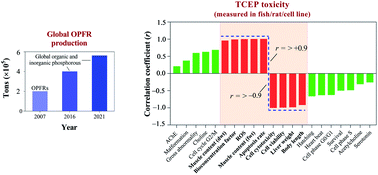Tris(2-chloroethyl) phosphate, a pervasive flame retardant: critical perspective on its emissions into the environment and human toxicity
Abstract
Regulations and the voluntary activities of manufacturers have led to a market shift in the use of flame retardants (FRs). Accordingly, organophosphate ester flame retardants (OPFRs) have emerged as a replacement for polybrominated diphenyl ethers (PBDEs). One of the widely used OPFRs is tris(2-chloroethyl) phosphate (TCEP), the considerable usage of which has reached 1.0 Mt globally. High concentrations of TCEP in indoor dust (∼2.0 × 105 ng g−1), its detection in nearly all foodstuffs (max. concentration of ∼30–300 ng g−1 or ng L−1), human body burden, and toxicological properties as revealed by meta-analysis make TCEP hard to distinguish from traditional FRs, and this situation requires researchers to rethink whether or not TCEP is an appropriate choice as a new FR. However, there are many unresolved issues, which may impede global health agencies in framing stringent regulations and manufacturers considering the meticulous use of TCEP. Therefore, the aim of the present review is to highlight the factors that influence TCEP emissions from its sources, its bioaccessibility, threat of trophic transfer, and toxicogenomics in order to provide better insight into its emergence as an FR. Finally, remediation strategies for dealing with TCEP emissions, and future research directions are addressed.



 Please wait while we load your content...
Please wait while we load your content...